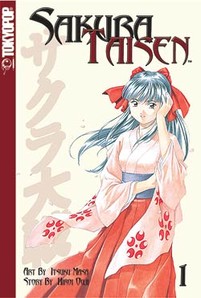Review
by Carlo Santos,Sakura Taisen
G.novel 1
| Synopsis: |  |
||
At the height of Japan's Taisho period, 1921, Ensign Ichiro Ogami has just graduated from the Naval Academy. He's looking forward to defending the country, but instead gets assigned to Tokyo's Imperial Theater... as a ticket-taker? Doing menial tasks and serving under a retired general is hardly his idea of military action. Then there's the Imperial Troupe, an international cast of girls that he has to deal with—prima donna Sumire, standoffish Maria, naïve Sakura, and young but precocious Iris. Surrounded by such unfamiliar circumstances, Ogami would rather get back into the Navy. His concerns only increase when a demon attacks the capital and steam-powered robots step in to fight. Just what is going on? |
|||
| Review: | |||
Could this be Sakura's last gasp? The Sakura Taisen/Wars franchise has somehow survived in anime's fickle landscape, starting out as a part-strategy-part-dating-sim game back when Sega still made consoles. It has since spawned several OVAs, a TV series, a movie, and finally arrives on the printed page... about six years too late. As a retelling of the series, the Manga Hits all the relevant points, but also looks like a desperate ploy to reach a dwindling fanbase. Think of it as one last chance to experience this harem action-adventure in the age of steam. If this adaptation is supposed bring in new Sakura Taisen fans, well, don't count on it. Most of Volume 1 is just a prelude: setting up the characters and their surroundings at the Imperial Theater, followed by an incongruous urban battle. After 180 pages, it's obvious that there's something more to Ogami's lowly assignment, but the slow buildup and lack of major revelations make it hard to get into the story. The only readers who are going to stick around are those who know that "it gets better." Ogami's romantic mishaps are too bland, a quaint echo of the harem genre in its early years (and apparently, fanservice had not yet been invented in 1921). As for the promise of steam-mecha action—well, there's only a few pages of it in the final chapter. With little focus on plot advancement, there's more room for exposition, but Ogami's encounters with the Imperial Troupe feel as contrived as their theatrical performances. Character interaction typically goes something like this: Ogami runs into girl, girl does something that indicates her personality, and Ogami responds in a mildly oafish way. Sadly, that's about all you need for exposition when the source material is a video game. The action segments—a military exercise at the start of the book and a demon battle at the end—flow more realistically, but the abrupt change in tone from the Imperial Theater storyline makes it feel like an entirely different series. What the story lacks in content, the art tries to make up for with a pleasant style; the character designs are an adept imitation of original designer Kōsuke Fujishima. Although the artwork tries to look as much like the anime as possible, a more individual style emerges in backgrounds and in combat. Early 1920's Tokyo comes to life here with intricate architecture and industrial-era street scenes. Likewise, the demon in the final chapter is drawn in greater detail than the main characters, making it stand out. The rectangular layouts across each page create a coherent but unexciting visual flow; the paneling works better in the final battle scene where tilted lines and angles crank up the energy. The production quality on this title is one of Tokyopop's better jobs, with the artwork looking consistently sharp on each page. The only problem is with the inside cover page, where an image of Sakura and Ogami looks blurry due to computer scanning. The dialogue has been translated in a plain, conversational style, thankfully avoiding pointless affectations of 1920's speech or slang. While most sound effects have been left alone in Japanese, a handful of minor ones have been replaced with English equivalents—seemingly for no other reason than because they could. Sakura Taisen fans who thought they'd seen the last of this pseudo-historical adventure series will probably enjoy this manga adaptation—true to the spirit of the original story, and with artwork that comes awfully close to the original designs. Newcomers, however, might want to think about one of the anime adaptations first—if at all. Although bolstered by the success of the games and a cadre of good-looking characters, the manga starts out too slowly to grab any first-time readers. Looks like the Imperial Flower Troupe is going for one last encore before bowing out at last. |
| Grade: | |||
|
Overall : C-
Story : D
Art : B
+ Pleasing art and effective action scenes. |
|||
| discuss this in the forum (2 posts) | | |||
| Production Info: | ||
|
Full encyclopedia details about Release information about |
||